Heavy Heavy | Dates 7 Jun 1099 – 15 Jul 1099 | |
 | ||
1,200-1,300 Knights11,000-12,000 Infantry Sizeable Garrison400 Elite Cavalrymen Results Decisive Crusader victory, Jerusalem captured by the Crusaders, Kingdom of Jerusalem is formed Similar | ||
The siege of jerusalem 1099
The Siege of Jerusalem took place from June 7 to July 15, 1099, during the First Crusade. The climax of the First Crusade, the successful siege saw the Crusaders seize Jerusalem from the Fatimid Caliphate and laid the foundations for the Kingdom of Jerusalem.
Contents
- The siege of jerusalem 1099
- Background
- Siege
- Final assault
- Massacre
- Muslims
- Jews
- Eastern Christians
- Aftermath
- References
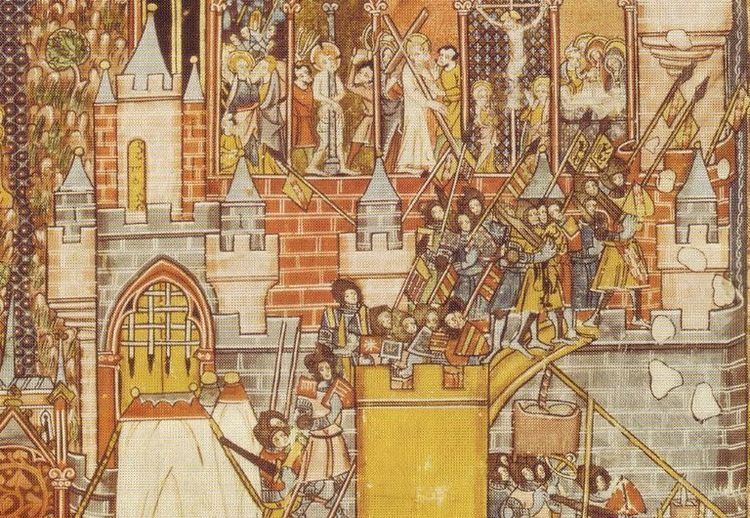
Background
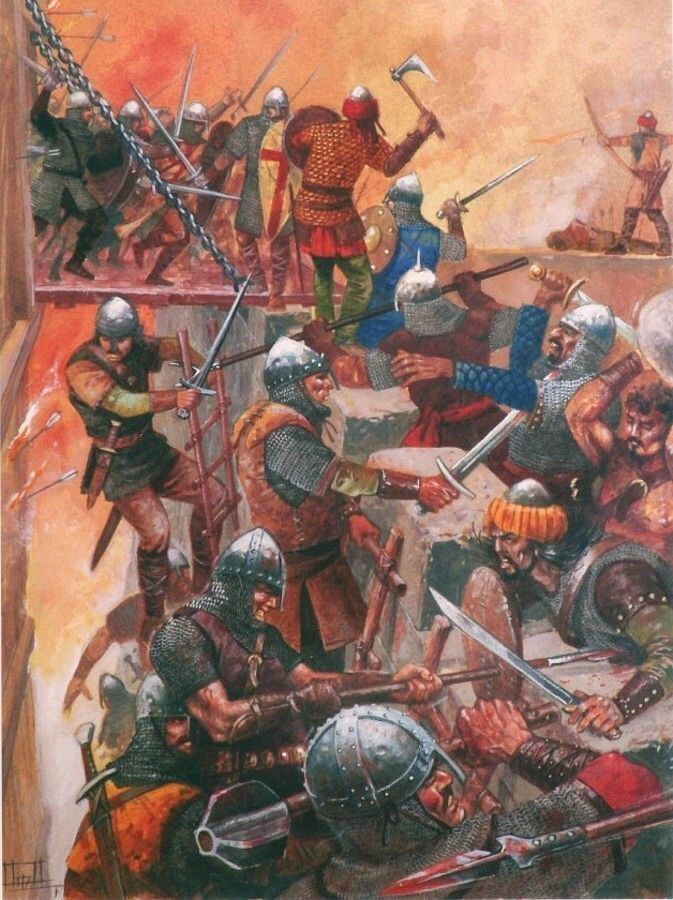
After the successful siege of Antioch in June 1098, the Crusaders remained in the area for the rest of the year. The papal legate Adhemar of Le Puy had died, and Bohemond of Taranto had claimed Antioch for himself. Baldwin of Boulogne remained in Edessa, captured earlier in 1098. There was dissent among the princes over what to do next; Raymond of Toulouse, frustrated, left Antioch to capture the fortress at Ma'arrat al-Numan in the Siege of Maarat. By the end of the year the minor knights and infantry were threatening to march to Jerusalem without them. Eventually, on January 13, 1099 Raymond began the march south, down the coast of the Mediterranean, followed by Robert of Normandy and Bohemond's nephew Tancred, who agreed to become his vassals.
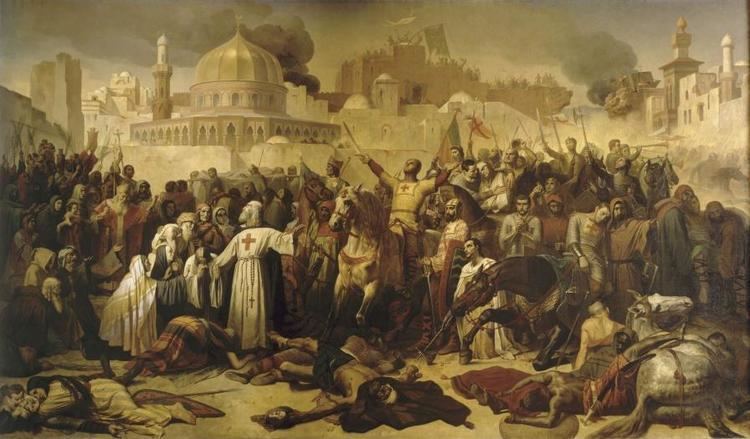
On their way the Crusaders besieged Arqa but failed to capture it and abandoned the siege on May 13. Fatimids had attempted to make peace, on the condition that the crusaders not continue towards Jerusalem, but this was ignored; Iftikhar ad-Daula, the Fatimid governor of Jerusalem, was aware of the Crusaders' intentions. Therefore, he expelled all of Jerusalem's Christian inhabitants. Further march towards Jerusalem met no resistance.
Siege
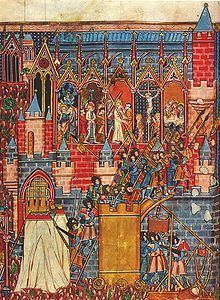
On 7 June, the crusaders reached Jerusalem, which had been recaptured from the Seljuqs by the Fatimids only the year before. Many Crusaders wept upon seeing the city they had journeyed so long to reach. As with Antioch the crusaders put the city to a siege, in which the crusaders themselves probably suffered more than the citizens of the city, due to the lack of food and water around Jerusalem. The city was well-prepared for the siege, and the Fatimid governor Iftikhar ad-Daula had expelled most of the Christians. Of the estimated 5,000 knights who took part in the Princes' Crusade, only about 1,500 remained, along with another 12,000 healthy foot-soldiers (out of perhaps as many as 30,000). Early in the siege, some low-class knights claimed to have been visited by Adhemar, the papal regate for the crusade, who recently died of typhus after the Siege of Antioch. They claimed that this was a Battle of Jericho situation, and that he instructed them to march around the city walls barefoot. They did so for a few days, singing holy chants. After which, Peter the Hermit held religious sermons in the Valley of Jehoshaphat, in the Garden of Gethsemane, and on the Mount of Olives, sending the crusading knights lost into religious zeal. It was at this time that they were ready for a siege. Godfrey, Robert of Flanders, and Robert of Normandy (who had now also left Raymond to join Godfrey) besieged the north walls as far south as the Tower of David, while Raymond set up his camp on the western side, from the Tower of David to Mount Zion. A direct assault on the walls on June 13 was a failure. Without water or food, both men and animals were quickly dying of thirst and starvation and the crusaders knew time was not on their side. Coincidentally, soon after the first assault, two Genoese galleys sailed into the port at Jaffa. The crusaders also began to gather wood from Samaria in order to build siege engines. They were still short on food and water, and by the end of June there was news that a Fatimid army was marching north from Egypt.
Final assault
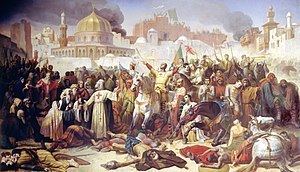
The prime need of the crusaders was for ladders and siege towers to scale the walls of Jerusalem. The Egyptian Fatimid garrison had cleared the surrounding area of trees. The crusaders sent foraging parties into Samaria to obtain wood and other materials. They found 400 pieces of prepared timber, enough to build two 50 foot siege towers, a battering-ram and several catapults. A fleet of Genoese ships commanded by Guglielmo Embriaco, had arrived at Jaffa in support of the land-based crusaders. These vessels were dismantled by the Genoese, providing wood and ropes suitable for siege equipment, notably additional siege towers.
On the night of July 14, the crusaders launched a two-pronged assault on the walls. One tower was to the south, the other to the northwest. The Muslims knew that if one siege tower breached the walls, Jerusalem would fall. The Muslims pelted the first siege tower with flaming arrows and pots of oil until it went up in flames. Now, only one siege tower was left, to the northwest under the command of the revered Duke Godfrey. Godfrey's tower took two hours to reach the weak spot of the walls near the northeast corner gate. According to the Gesta two Flemish knights from Tournai named Lethalde and Engelbert were the first to cross into the city, followed by Godfrey, his brother Eustace, Tancred, and their men. Raymond's tower was at first stopped by a ditch, but as the other crusaders had already entered, the Muslim guarding the gate retreated.
Massacre
Although conquerors committing atrocities against the inhabitants of cities taken by storm after a siege was the norm in medieval warfare, the massacre of the inhabitants of Jerusalem likely exceeded even these standards.
Muslims
Many Muslims sought shelter in the Al-Aqsa Mosque, the Dome of the Rock, and the Temple Mount area generally. According to the Gesta Francorum, speaking only of the Temple Mount area, "...[our men] were killing and slaying even to the Temple of Solomon, where the slaughter was so great that our men waded in blood up to their ankles..." According to Raymond of Aguilers, also writing solely of the Temple Mount area, " in the Temple and porch of Solomon men rode in blood up to their knees and bridle reins." Writing about the Temple Mount area alone Fulcher of Chartres, who was not an eyewitness to the Jerusalem siege because he had stayed with Baldwin in Edessa at the time, says: "In this temple 10,000 were killed. Indeed, if you had been there you would have seen our feet coloured to our ankles with the blood of the slain. But what more shall I relate? None of them were left alive; neither women nor children were spared".
The eyewitness Gesta Francorum states that some people were spared. Its anonymous author wrote, "When the pagans had been overcome, our men seized great numbers, both men and women, either killing them or keeping them captive, as they wished." Later the same source writes, "[Our leaders] also ordered all the Saracen dead to be cast outside because of the great stench, since the whole city was filled with their corpses; and so the living Saracens dragged the dead before the exits of the gates and arranged them in heaps, as if they were houses. No one ever saw or heard of such slaughter of pagan people, for funeral pyres were formed from them like pyramids, and no one knows their number except God alone. But Raymond caused the Emir and the others who were with him to be conducted to Ascalon, whole and unhurt."
Another eyewitness source, Raymond of Aguilers, reports that some Muslims survived. After recounting the slaughter on the Temple Mount he reports of some who "took refuge in the Tower of David, and, petitioning Count Raymond for protection, surrendered the Tower into his hands." These Muslims left with the Fatimid governor for Ascalon. A version of this tradition is also known to the later Muslim historian Ibn al-Athir (10, 193–95), who recounts that after the city was taken and pillaged: "A band of Muslims barricaded themselves into the Oratory of David (Mihrab Dawud) and fought on for several days. They were granted their lives in return for surrendering. The Franks honoured their word, and the group left by night for Ascalon." One Cairo Geniza letter also refers to some Jewish residents who left with the Fatimid governor.
Tancred claimed the Temple quarter for himself and offered protection to some of the Muslims there, but he was unable to prevent their deaths at the hands of his fellow Crusaders.
Although the Crusaders killed many of the Muslim and Jewish residents, eyewitness accounts (Gesta Francorum, Raymond of Aguilers, and the Cairo Geniza documents) demonstrate that some Muslim and Jewish residents were allowed to live, as long as they left Jerusalem.
Jews
Jews had fought side-by-side with Muslim soldiers to defend the city, and as the Crusaders breached the outer walls, the Jews of the city retreated to their synagogue to "prepare for death". According to the Muslim chronicle of Ibn al-Qalanisi, "The Jews assembled in their synagogue, and the Franks burned it over their heads." A contemporary Jewish communication confirms the destruction of the synagogue, though it does not corroborate that any Jews were inside it when it was burned. This letter was discovered among the Cairo Geniza collection in 1975 by historian Shelomo Dov Goitein. Historians believe that it was written just two weeks after the siege, making it "the earliest account on the conquest in any language." Additional documentation from the Cairo Geniza indicates that some Jews held captive by the Crusaders were able to escape when the Ascalon Jewish community paid a ransom.
Eastern Christians
Contrary to what is sometimes alleged, no eyewitness source refers to Crusaders killing Eastern Christians in Jerusalem, and early Eastern Christian sources (Matthew of Edessa, Anna Comnena, Michael the Syrian, etc.) make no such allegation about the Crusaders in Jerusalem. According to the Syriac Chronicle, all the Christians had already been expelled from Jerusalem before the Crusaders arrived. Presumably this would have been done by the Fatimid governor to prevent their possible collusion with the Crusaders.
The Gesta Francorum claims that on Wednesday August 9, two and a half weeks after the siege, Peter the Hermit encouraged all the "Greek and Latin priests and clerics" to make a thanksgiving procession to the Church of the Holy Sepulchre. This indicates that some Eastern Christian clergy remained in or near Jerusalem during the siege. In November 1100, when Fulcher of Chartres personally accompanied Baldwin on a visit to Jerusalem, they were greeted by both Greek and Syrian clerics and laity (Book II, 3), indicating an Eastern Christian presence in the city a year later.
Aftermath
Following the battle, Godfrey of Bouillon was made Advocatus Sancti Sepulchri ("advocate" or "defender of the Holy Sepulchre") on July 22, refusing to be named king in the city where Christ had died, saying that he refused to wear a crown of gold in the city where Christ wore a crown of thorns. Raymond had refused any title at all, and Godfrey convinced him to give up the Tower of David as well. Raymond then went on a pilgrimage, and in his absence Arnulf of Chocques, whom Raymond had opposed due to his own support for Peter Bartholomew, was elected the first Latin Patriarch on August 1 (the claims of the Greek Patriarch were ignored). On August 5, Arnulf, after consulting the surviving inhabitants of the city, discovered the relic of the True Cross.
On August 12, Godfrey led an army, with the True Cross carried in the vanguard, against the Fatimid army at the Battle of Ascalon. The crusaders were successful, but following the victory, the majority of them considered their crusading vows to have been fulfilled, and all but a few hundred knights returned home. Nevertheless, their victory paved the way for the establishment of the Crusader Kingdom of Jerusalem.
The siege quickly became legendary and in the 12th century it was the subject of the Chanson de Jérusalem, a major chanson de geste in the Crusade cycle.
